Around 90 million small businesses use Facebook to connect and attract new customers. If we look even closer at that number, you’ll learn that almost 80% of real estate agents have a Facebook page to find and sell to prospects.
Facebook marketing is a worthy investment for real estate agents like yourself. It has the power to expand your reach, not just locally but globally.
Studies found that Facebook bought in the most 62% of traffic to a brand’s website and not to mention 74% of Facebook users are high-income earners.
The road to Facebook marketing success for real estate agents isn’t an instant fix. It takes time, effort, and dedication to growing your following and customer base. I’ll be showing you in-depth on how to optimize your Facebook page for sales.
Facebook Profile Update & Optimization
Before we can start putting everything in place to generate prospects and real estate leads, you’ll need to update your Facebook profile like a professional marketer!
1. Create a Facebook Page
If you already have a Facebook business page for your real estate business or profession, then you can skip this section. If you don’t have a Facebook business page or you’re still using your personal Facebook account for business, then listen up!
Douglas Elliman Real Estate
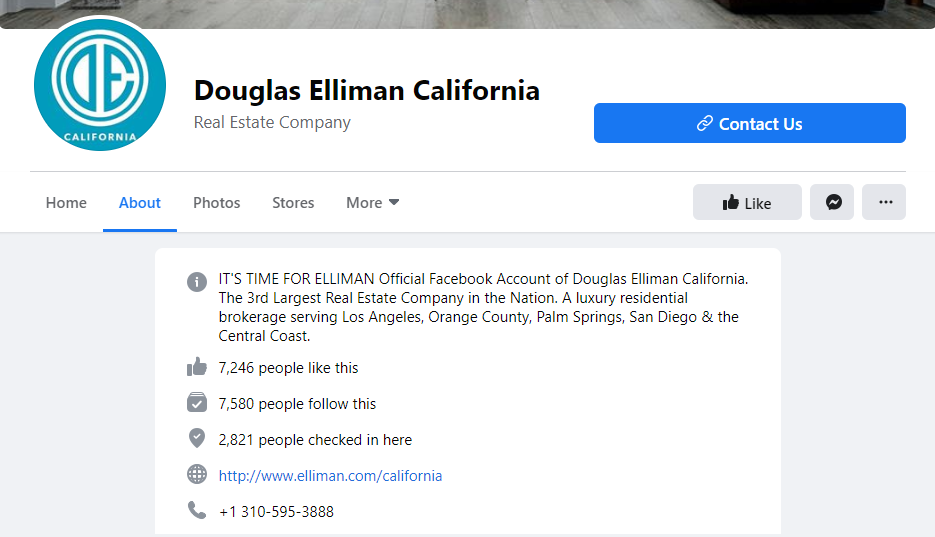
Your first step towards Facebook marketing should be to set up a page dedicated to your real estate brand. A Facebook business page allows you to use features, tools, and analytics that isn’t available with a personal account. Facebook found that 6 in 10 local businesses say having an online presence is essential or their long-term success.
Get started with Hootsuite’s guide, How to Create a Facebook Business Page in 7 Easy Steps.
2. Update Facebook Profile Picture
When was the last time you updated your Facebook profile picture? Your profile picture allows people to identify your account easily if they’re searching for it.
People see your profile and cover image before they read your bio, captions, or take a deeper dive into your post. This is where first impressions matter the most!
Miami Real Estate – Luis Iglesias
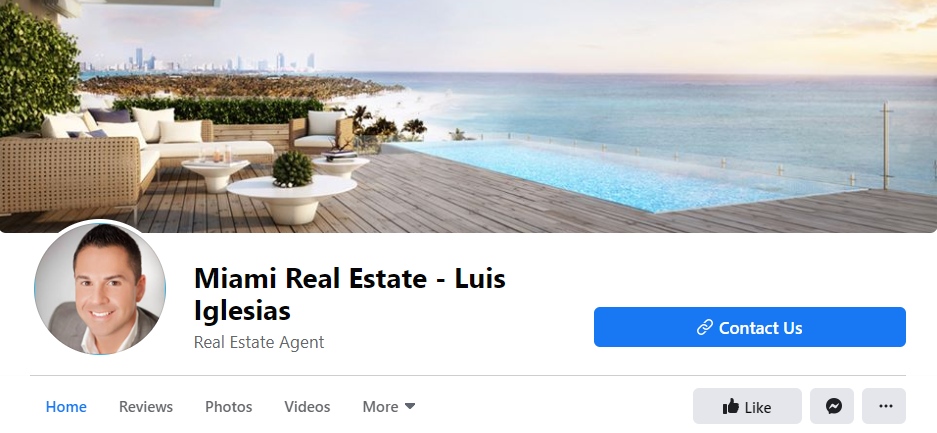
Your profile picture can be your logo, a professional headshot, or your real estate team! At the end of the day, it should do the following:
- Look professional and vibrant
- Use the ideal Facebook size of 360 x 360 pixels or 180 x 180 pixels
- Highlights your best quality and features
- Positively represents your brand.
Pro Tip: Using the same profile picture across multiple social media platforms allows your followers and clients to quickly spot your account.
3. Update Cover Image
Adding a cover image is also another important factor when it comes to first impressions. It’s your second introductory after your viewer has seen your profile image. Your cover image can have a bit more context than your profile image. A Facebook cover can be an image with graphics or a video.
The McKenzie Ryan Real Estate Company hosts a monthly video campaign where they give real estate tips to prospects and sellers. They use their Facebook cover to help promote it!
McKenzie Ryan Real Estate Company
According to Facebook, your cover photo displays at 820 pixels wide by 312 pixels tall on computers and 640 pixels wide by 360 pixels tall on smartphones.
However, Snappa recommend using the dimensions 820px by 360px and to keep all text and graphics in the middle safe zone as per the specifications below so your cover image can be seen properly via desktop or mobile:
4. Update Facebook Contact & Information
Sprout Social found that about 64% of consumers want brands to connect with them and that social media is the number one channel for brands to connect with consumers.
Orlando Real Estate
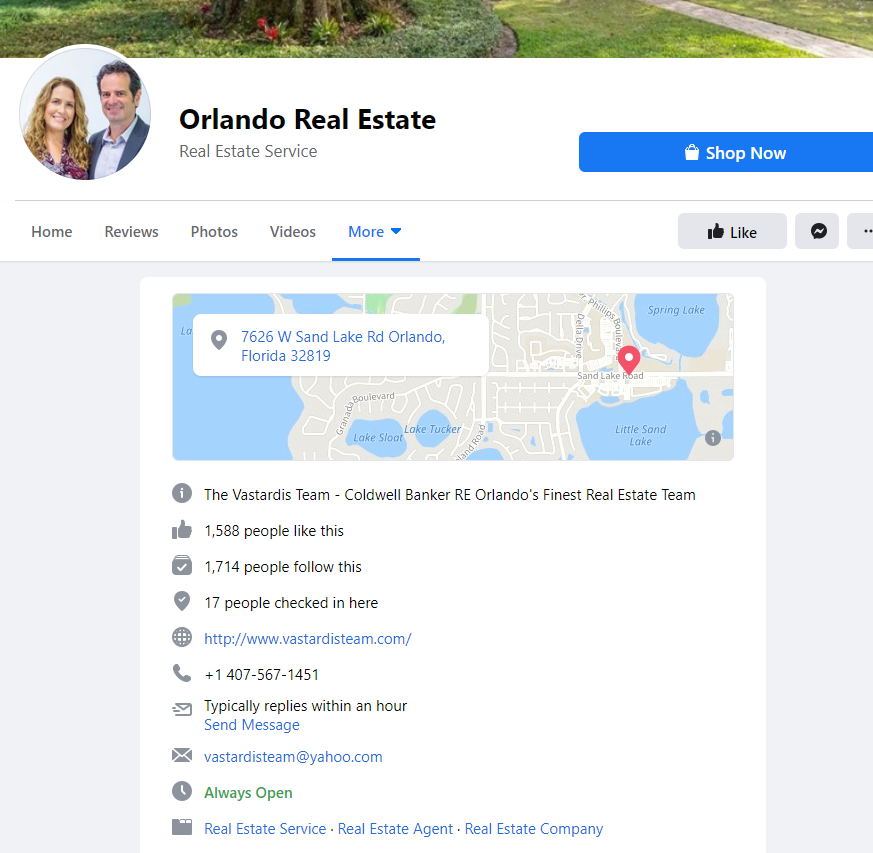
When customers go on your Facebook page, they expect to find all multiple ways to contact and get to know you. When you leave your contact information empty or outdated, you stop your customers from making contact with you. As such, you’ll need to update and fill in your business page’s contact information.
Update your website link, email, bio/description, address, and more! If you’re ready to update or add your contact information, here are six steps to get started:
- Click your profile picture in the top right.
- Click About > Contact and Basic Info.
- Click or select “add information.”
- Add or change the information you’d like to edit.
- Make changes to the privacy of your information by selecting the current privacy setting (example: Public, Friends, or Only Me).
Click Save.
5. Create Facebook Tabs & CTA
Facebook allows you to add a large CTA to your business page. This big blue button allows you to drive traffic to a specific link or get people in your messaging inbox.
Facebook offers a variety of CTA’s that work alongside their purpose. For example, CTA includes: “Send Message,” “Apply Now,” “Download,” “Learn more,” and “Contact Us.”
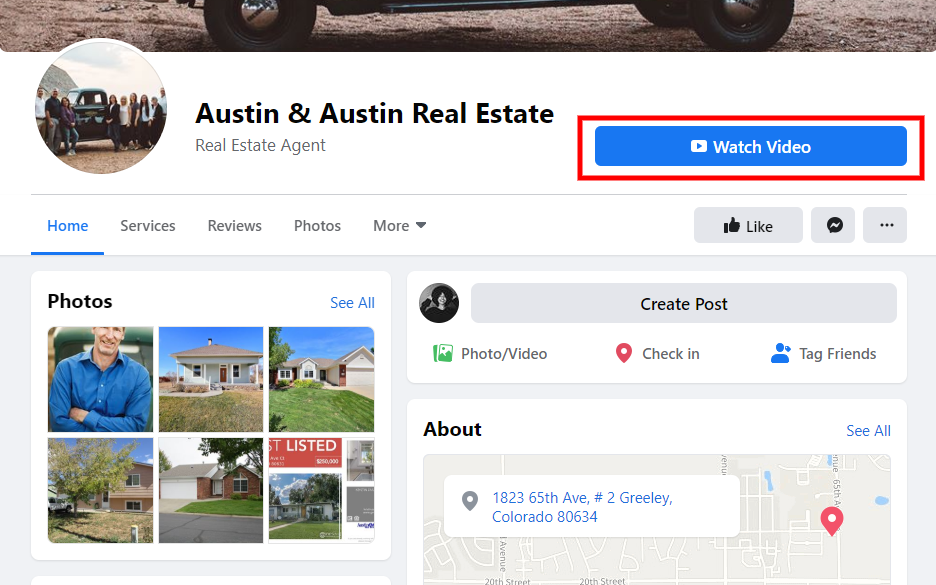
6. Claim Your Vanity URL to Boost Facebook SEO
Each Facebook business page comes with a vanity URL, and this is a specialized Facebook page URL that’s one of the top Facebook SEO tips.
Instead of having a Facebook page URL: facebook.com/mybusinessname/5478569871236.
Your vanity URL link can be this instead: facebook.com/mybusinessname.
To get started, go onto www.facebook.com/username, select your business page, and then claim your link.
Check out more from Post Planner’s Guide on Claiming Your Facebook Vanity URL.
7. Set Up Your Facebook Chat Features
An Edison Research study found that not only do consumers expect companies to have social media channels, they also expect them to be ready to respond quickly there. 42% of social media users expect a response in under an hour, 25% in the same day, and 9% want it in 5 minutes!
Luckily Facebook provided business owners and real estate agents a solution. Automated responses and saved replies.

Here’s a quick guide to learn how to create an auto-reply on Facebook Messenger:
*Click Settings at the top of your Page.
*Click Messaging in the left column.
*Below Response Assistant, click to select On next to Send Instant Replies to anyone who messages your Page.
*To change your instant reply message, click Change, update the message and click Save.
8. Allow Reviews on Your Facebook Page
Reviews can be the heart and soul for a real estate agents’ reputation, and the same goes for your online reputation. Nearly 95% of shoppers read online reviews before making a purchase, which includes purchases from service providers.
Roberts Real Estate

Showing off your reviews, especially your best reviews, can give new clients the confidence to do business with you.
Facebook allows you to turn on or off or moderate reviews. Here’s how to get the Reviews tab to show up on your Facebook Page:
1.Click “Settings”
2.Click “Edit Page”
3.You will see a section titled Tabs
4.Turn ON the option to “Use default tabs”
5.There, choices for pre-picked tabs will show up
6. Scroll down until you see “Add a Tab.” Click it.
7. Add the “Reviews” tab
Pro Tips: After you’ve closed a deal with a client, send them a thank you follow up email and a link to your Facebook page to leave a positive review!
Facebook Content Marketing Ideas
Marketing expert Julie Fleischer once said: “Content Marketing provides 4x the ROI of our traditional marketing spend.” If you’re wondering how to gain success on Facebook, these three significant factors will influence your marketing success: content, engagement, and ads.
In this section, we’ll be talking about content and engagement and how you can use the following tips and ideas to start publishing eye-catching content your (potential) customers will love.
1. Create Content that Educates
The most important content a professional in any industry can provide their followers and customers is content that educates. For new homeowners (to be) or persons looking to sell, it can be a scary time. Lack of information, what’s expected, and how to deal with the process can stop them from taking the first step.
Instead, create content that provides tips and methods to make their buying/selling process more comfortable. Sharing educational content allows you to connect effortlessly with customers, and it shows off your realtor credibility, informed, and trustworthy.
Platinum Real Estate

2. Invest in Great Photography & Content Tools
As a realtor, you know that first impressions count, so you want to make sure that the images and content/graphics you choose to leave a positive impact.
Start investing in a good camera (or quality camera phone lense) and lighting tools. Lighting tools like ring lights and softboxes start at $19 and up so you can find equipment that fits your budget.
Maura Kane, Realtor. Coldwell Banker Weir
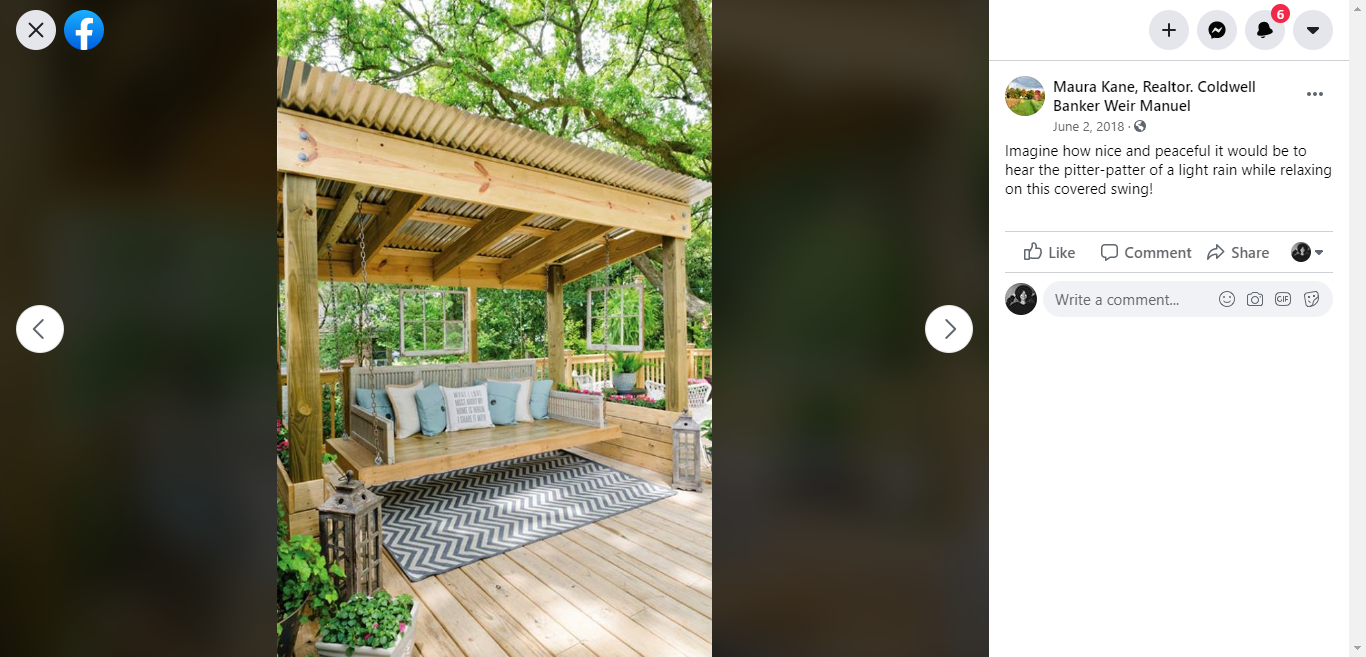
If you can’t afford to buy a camera or use a photographer for daily projects, then try investing in a phone that has exceptional camera reviews. You also might want to try these 38 real estate photography tips & mistakes to avoid.
3. Upload Engaging Videos on Facebook
More than 4 billion video views take place on Facebook every day. Video content is one of the most sought out types of content across all social media platforms. Unlike text, you can say and show a whole lot with video content.
Not only is using video an essential part of any marketing plan, but social media posts with video have 48% more views than static images. The more views your listing has, you increase your chances to catch a potential buyer’s eye.
Joyce Rey Luxury Real Estate
Pro Tip: Facebook users watch 85% of Facebook videos without sound, so make sure you have captions or the first 30 seconds is engaging enough for them to turn on the audio.
4. Share Eye-Catching Listings & Rentals
Another form of content your Facebook page needs are beautiful images of listings and rentals that you have to offer. Capture images from different angles, rooms, and even neighborhood features.
Your images should effectively showcase your listing and the experience that customers will have once they purchase their new home.
Allison L. Chiaramonte
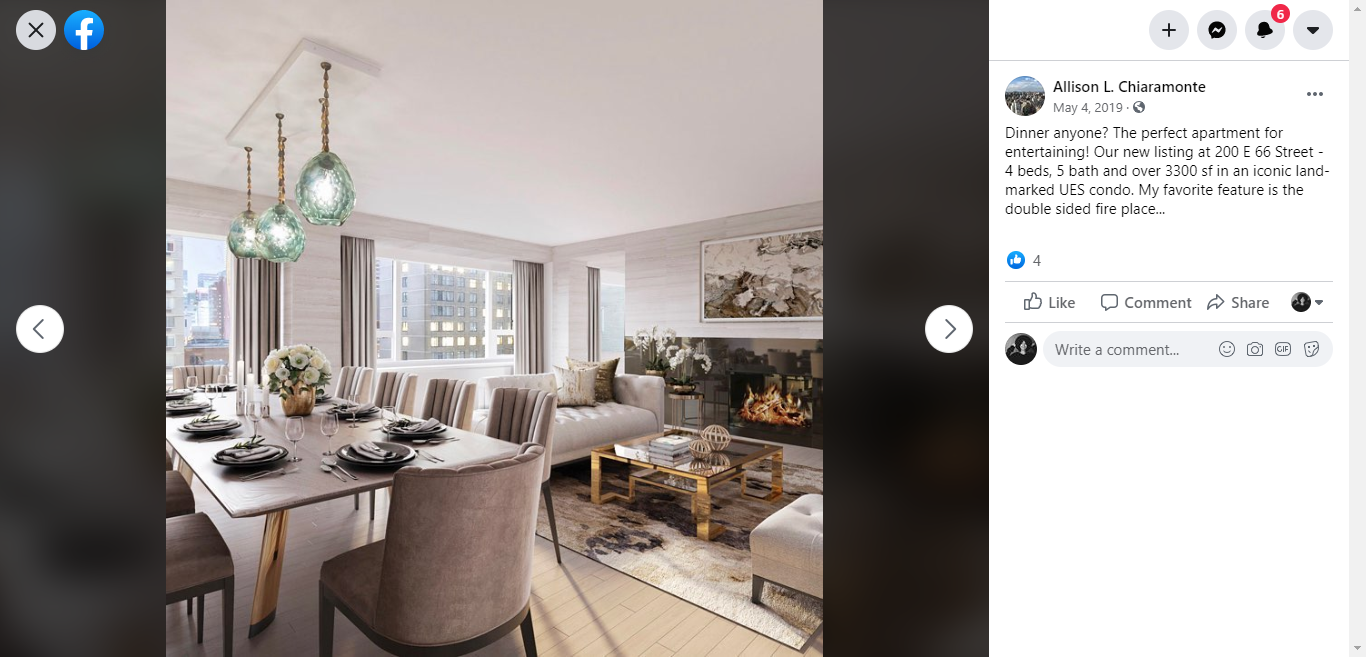
Here’s some friendly listing photography do’s and don’ts you should follow:
- Spic and Span: Before you start showing off your listing, make sure that the area is free from clutter and mess. You want to put your best listing forward, so clean up!
- Clean Walls: People can see dirty handprints and cobwebs, so be sure to paint that over or stay clear of it when taking pictures.
- Lighting: Earlier, we spoke about how important lighting can be for content. Sharing a picture of a dark room will not get buyers running towards you.
- Edit or Add Filters: Adding some minor touches to your pictures can make a world of difference. You can sharpen, increase the brighten and highlight with tools like VSCO or AirBrush.
5. Use Facebook Publisher or Social Media Management Tool
Facebook now is a publishing tool inside. It’s a platform that allows you to publish, draft, or schedule all of your social media content.
Stories, posts, videos can be edited and scheduled for a week in advance. You can access a creator studio, additional content tools, and a sound collection you use when editing videos.
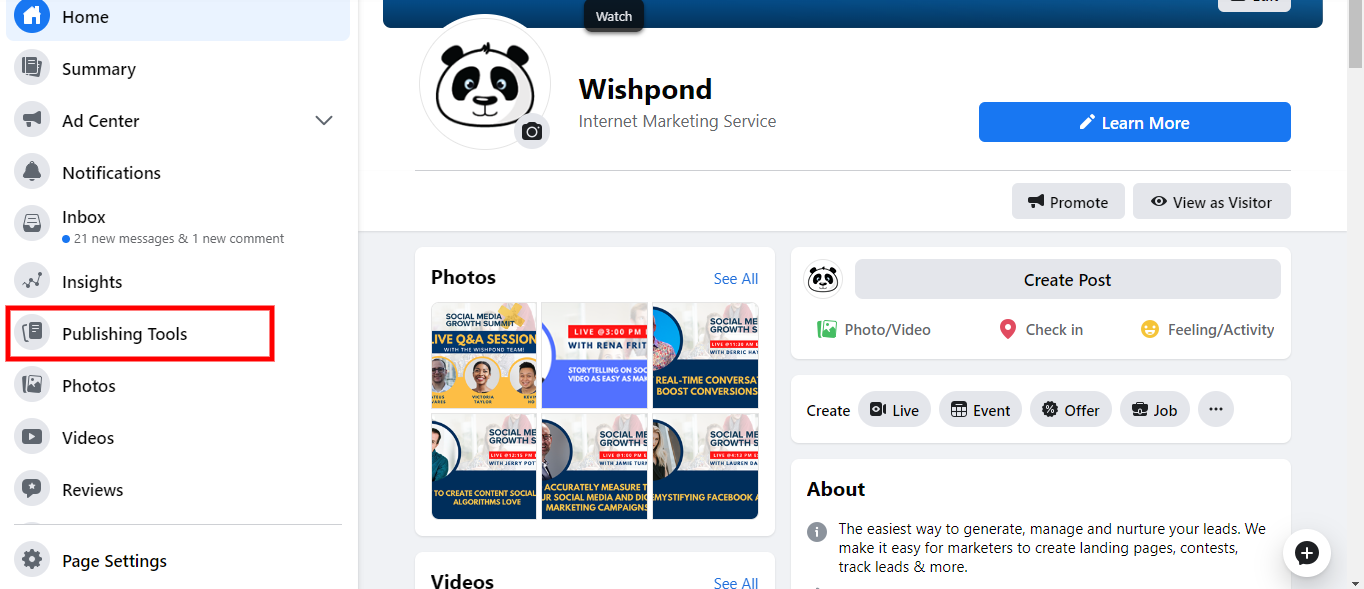
If you have multiple social media accounts, then you should consider using tools like Hootsuite or Buffer to schedule all your content in one place.
6. Show Off Your Customers
Once you’ve gotten customers to send reviews, it’s time to add them to your Facebook content. Share them weekly or monthly, and you want as many people.
When you’re taking pictures of your customers, remember it’s all about them, not you. Don’t force them to smile or hold up a sign, instead ask. When people are comfortable taking pictures, it shows.
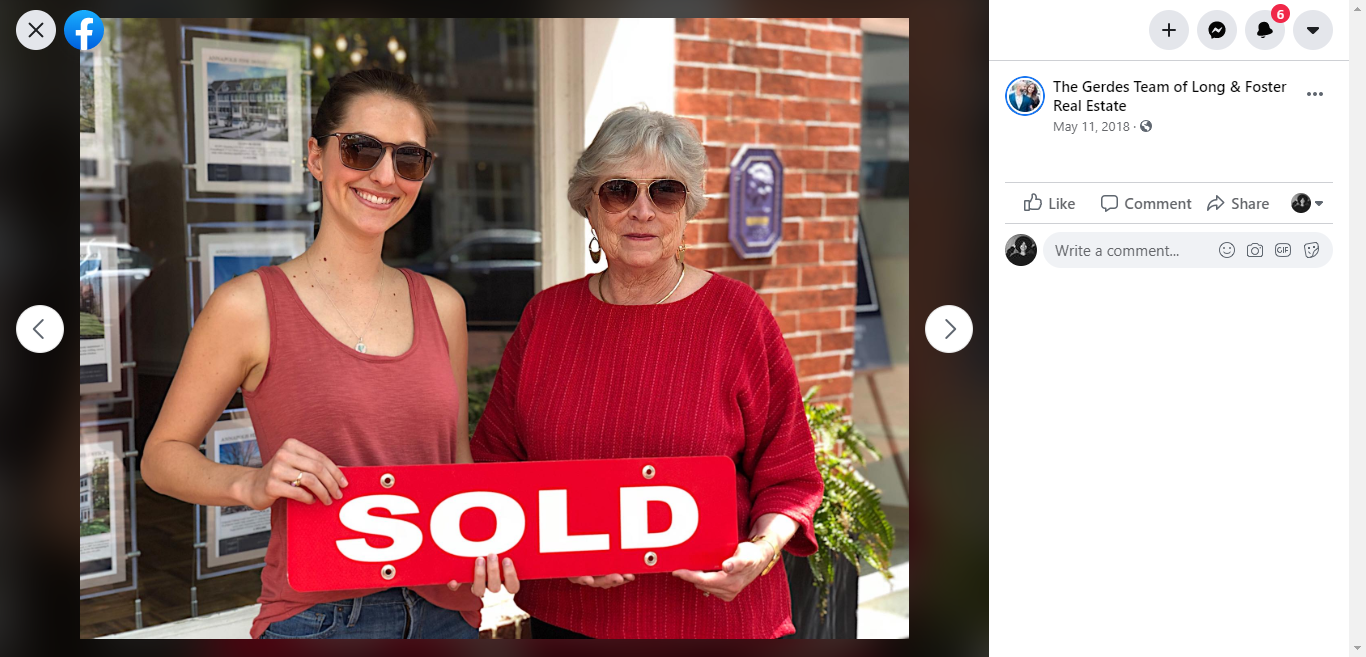
7. Create a Branded Hashtag
A branded hashtag is a hashtag that’s created specifically for your social media account. Hashtags make your content discoverable and act as a form of SEO. For example, if your company is Sally’s Real Estate, then your branded hashtag can be #sallysrealestate.
When people click or search for that hashtag, they’ll instantly find content associated with your account.
8. Respond to Comments and Likes
The average engagement rate for Facebook posts is 3.6%. Why is engagement so important? When people engage with your content, it shows that they are interested in what you have to say and what you have to sell.

When someone leaves a comment on your post, take the initiative and respond to them. Whether it’s about your services, the content in your post, or just saying hello, when other people see that you respond to comments, it encourages them to reach out to you.
When you’re marketing online, it’s a bit harder to connect with people. Responding to comments makes you more approachable and open the door to potential conversations.
9. Boost Engagement By Following These Five Types of People
It’s important to stay in the loop when using social media. This is especially true if you’re new to Facebook. Make sure to engage, comment, and follow these five types of people to grow your real estates Instagram account:
- Past clients: Keep in content with past clients so your post can be fresh in their feeds as a reminder to them to refer you to friends and family, or do business with you again.
- Current/potential clients: Let them feel like you want to engage with them on a professional level. This also allows you to do some research, see what they like, recent family updates, and more, so when you meet in-person, you can build rapport.
- Local business owners: You can connect and network with them.
- Local community influencers: You can reach out to them as potential clients to build your online credibility.
- Local real estate agents or companies: Stay in the loop and watch your competitors and see how you can stay relevant or ahead.
Facebook Ad Campaign & Lead Generation Tips
This section is a brief overview of tips, and tools realtors can use when creating ads and using Facebook to generate potential leads or prospects.
1. Install Your Facebook Pixels on Your Site
Facebook pixels are lines of code installed on your website that lets you measure, optimize, and build audiences for your ad campaigns.
This piece of code also allows you to retarget a specific audience that landed on your website through a Facebook campaign.
Facebook business describes how pixels work exactly: When someone visits your website and takes action (for example, buying something), the Facebook pixel is triggered and reports this action.
This way, you’ll know when a customer took action after seeing your Facebook ad. You’ll also be able to reach this customer again by using a custom audience.
When more and more conversions happen on your website, Facebook gets better at delivering your ads to people who are more likely to take certain actions. This is called conversion optimization.
Ensure that you or your ad manager install your pixels before running ads or doing ad campaigns. Here’s a Facebook approved Pixel Set-up Guide.
2. Drive Traffic to Your Landing Page or Website
Facebook alone is a good tool, but when used to drive traffic or redirect viewers to your website or service pages, it can work wonders.
The key to making the most out of your ad budget is using a specific page to redirect viewers, helping you to meet your goals effectively and have a more specialized CTA for your ads.

For instance, let’s say that you have multiple listing you’d like to show off, instead of creating one big ad to show them all, give your most prized listing their very own Facebook ad. Or you could group list based on the same locations. This ensures:
a) You’re targeting customers who are looking for something specific.
b) It’ll allow you to drive traffic directly to where you want it to go.
Here’s a guide on How to Use Facebook Ads for Local Businesses (And Why They Work).
3. Create a Detailed Target Audience
When you’re creating your Facebook ad campaign, it’s important to have a specific target audience. Like Marketing, if everyone is your customer, there no one is your customer. When you have a defined target audience, you increase your ads’ chance of success.
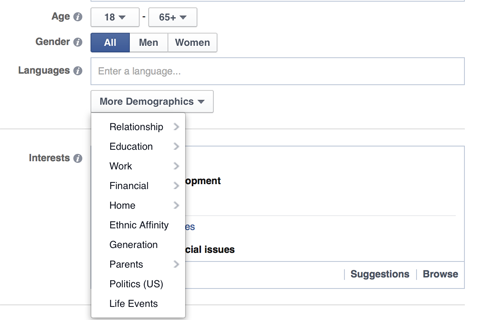
Facebook allows you to choose interest, location, age, radius, country, and more. You can also A/B test the audience with the “Lookalike Feature.”
Ready to master your real estate Facebook target audience? Check out Sprout Social’s How to Master Facebook Ad Targeting & Zero-In on Your Audience. to get started.
4. Create Mobile Ads and Content
We live in a world where people are consistently glued to their phone or desktop, having an ad campaign that fits both platforms will increase your chances of conversions.

Facebook found that Mobile-first video ads make up more than half of Facebook’s video revenue, and it makes sense, why? As more users opt to access Facebook from a mobile device, advertisers need to shift their strategies to accommodate that, which means creating videos specifically designed for mobile.
5. A/B Test Your Facebook Ads
A/B Testing allows you to test two versions of the same ad with slight variations, A and B, (the Control and the Treatment) are tested against each other to see which ad gets the most conversions or clicks. The goal is to identify changes that increase the chance of what you want to occur, occurring.
- A/B Testing your Image: Sometimes, the winning image of a listing we select won’t always win over prospects. If you notice your real estate Facebook ad isn’t getting enough clicks, then it’s time to change things up. Try using the image of the inside, outside, or the neighborhood around your listing and see which works best.
- A/B Testing your Title: Think of your ad titles like movie headlines, giving prospects a sneak peek as to what they can expect if they should buy or inquire about your listing. If you’re thinking about A/B testing your title, then check out Coschedule’s Headline Analyzer to test your titles.
- A/B Testing your Target Audience: Try A/B testing your target audience. Again sometimes the people we think would be interested in our listing might not look at your ads. Try targeting persons with a certain financial status, location, ages, and specific interest.
Summary
Real estate marketing with Facebook is a worthy investment to gain prospects and sell listing to targeted customers. It can seem like a hand full, but once you overcome your Facebook learning curve, you’ll be a pro in no time.
Need more help with Facebook marketing for your real estate company? Here are some gems to keep you afloat:
- The Complete Real Estate Facebook Marketing Guide!
- 20 Tips For Amazing Real Estate Instagram Posts
- 6 Facebook Ad Image Best Practices that will Send your Click-Through-Rate to the Moon
- 12 Real Estate Infographics to Improve Your Business Communications

